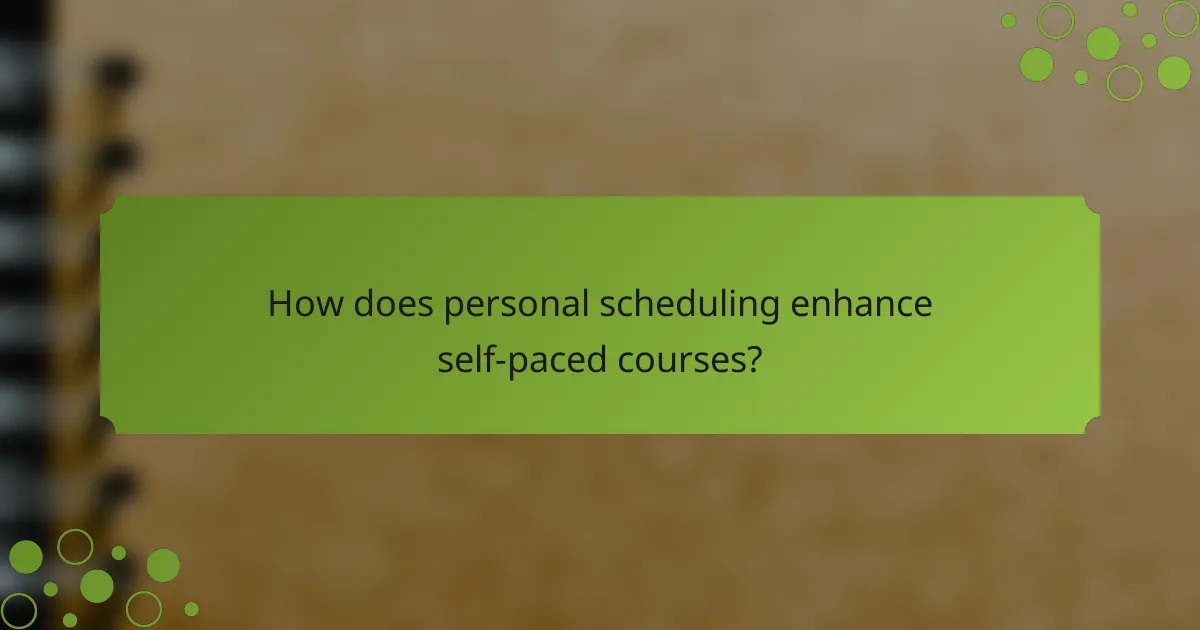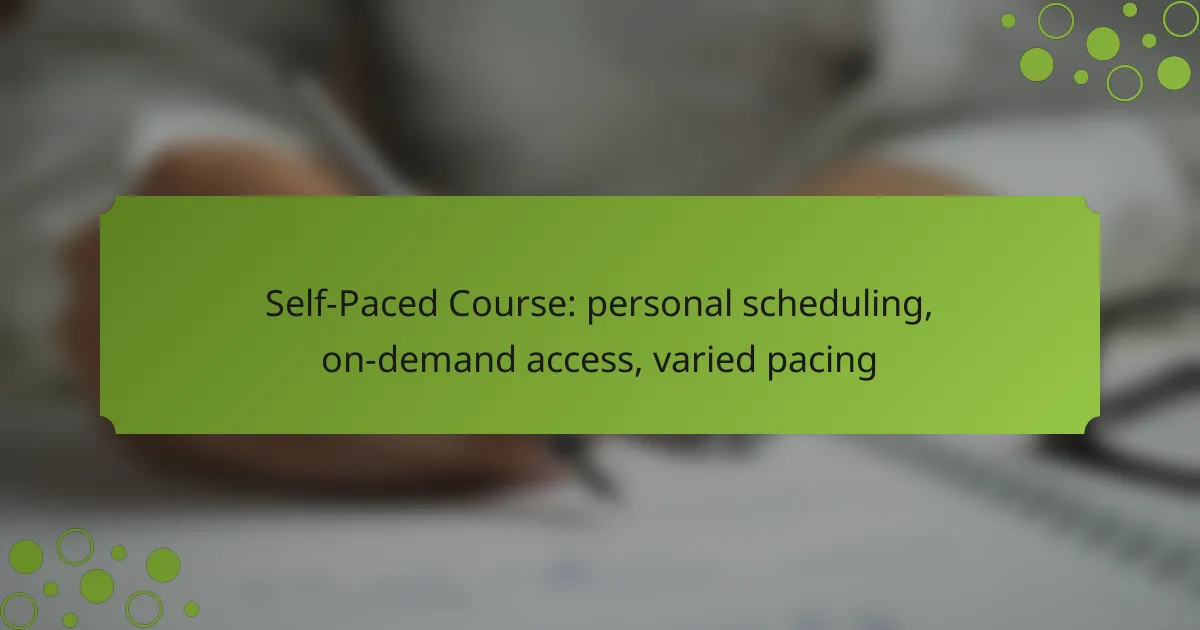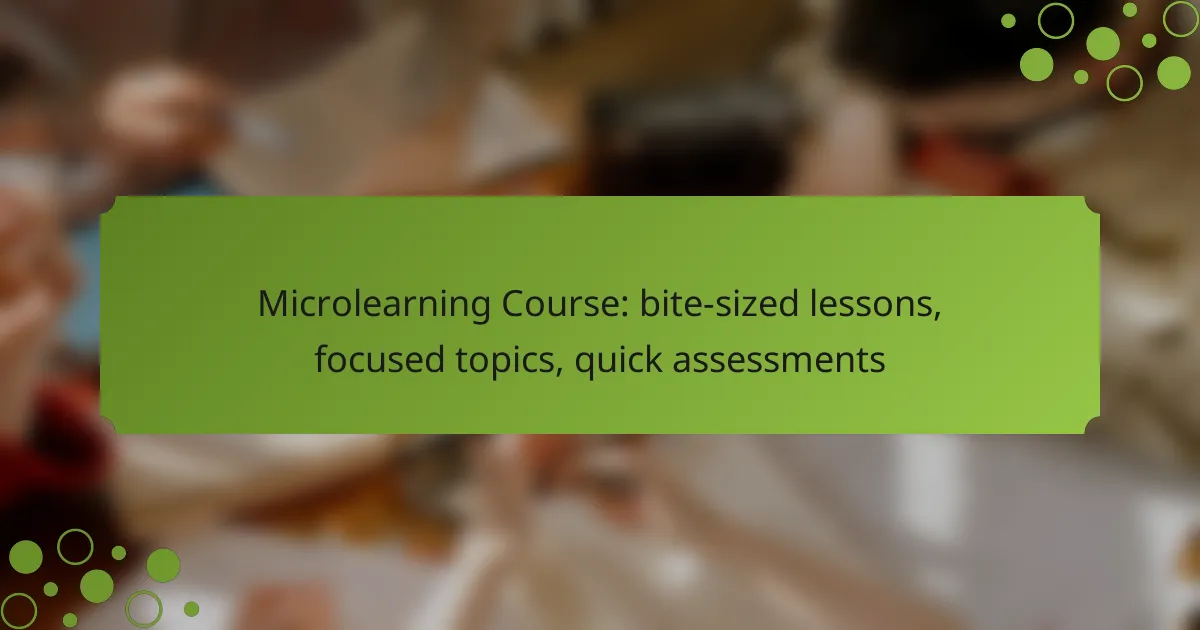Self-paced courses offer the unique advantage of personal scheduling, enabling learners to choose their study times based on individual preferences and commitments. With on-demand access to materials, students can engage with content whenever it suits them, enhancing convenience and accessibility. Additionally, varied pacing allows learners to progress at their own speed, fostering deeper understanding and retention of the material.

How does personal scheduling enhance self-paced courses?
Personal scheduling significantly enhances self-paced courses by allowing learners to tailor their study times according to their individual preferences and commitments. This flexibility leads to more effective learning experiences, as students can engage with the material when they are most focused and motivated.
Flexible time management
Flexible time management is a key benefit of personal scheduling in self-paced courses. Learners can allocate study time around their existing commitments, such as work or family responsibilities, which helps them maintain a balanced lifestyle. For instance, someone working full-time may choose to study in the evenings or on weekends, ensuring they can fully dedicate their attention to the course material.
This adaptability allows students to progress at their own pace, reducing stress and preventing burnout. By setting their own schedules, learners can also take breaks when needed, which can enhance retention and understanding of the content.
Improved learning outcomes
Personal scheduling can lead to improved learning outcomes by enabling students to engage with the material in a way that suits their learning style. When learners have control over their study times, they are more likely to retain information and achieve better results. For example, a student who prefers to study in short bursts may schedule multiple brief sessions throughout the day instead of long, uninterrupted blocks.
Additionally, learners can revisit challenging topics as needed, reinforcing their understanding and mastery of the subject matter. This approach often results in higher completion rates and better performance on assessments.
Customization for individual needs
Customization for individual needs is a significant advantage of personal scheduling in self-paced courses. Each learner has unique preferences, strengths, and weaknesses, and personal scheduling allows them to create a study plan that reflects these differences. For instance, a visual learner might choose to spend more time on video content, while an auditory learner may prefer podcasts or discussions.
Moreover, students can adjust their schedules based on their progress and comprehension levels. If a particular module proves challenging, they can allocate additional time to that area without feeling rushed. This personalized approach fosters a deeper understanding and a more satisfying learning experience overall.

What are the benefits of on-demand access in self-paced courses?
On-demand access in self-paced courses allows learners to engage with materials whenever they choose, offering flexibility and convenience. This approach caters to individual schedules and learning preferences, making education more accessible and tailored to personal needs.
24/7 availability
With on-demand access, course materials are available around the clock, enabling learners to study at any time that suits them. This flexibility is particularly beneficial for those balancing work, family, or other commitments, as it allows for learning during off-peak hours or whenever free time arises.
For example, a busy professional can review course content during lunch breaks or late at night, ensuring that education fits seamlessly into their lifestyle. This constant availability eliminates the constraints of traditional class schedules.
Access to diverse resources
On-demand courses typically provide a wide range of resources, including videos, articles, quizzes, and interactive activities. This variety caters to different learning styles, allowing students to choose the formats that resonate most with them.
For instance, visual learners may prefer video lectures, while others might benefit from reading materials or hands-on exercises. The ability to switch between these resources enhances understanding and retention of the subject matter.
Learning at your own pace
Self-paced courses empower learners to progress through materials at a speed that suits their individual comprehension levels. This means that students can take extra time on challenging topics or move quickly through areas they already understand.
For example, a learner struggling with a complex concept can spend additional hours reviewing it without the pressure of keeping up with a class. This personalized pacing can lead to deeper mastery of the material and a more satisfying educational experience.

How does varied pacing impact learning effectiveness?
Varied pacing significantly enhances learning effectiveness by allowing learners to progress at their own speed, which can lead to deeper understanding and retention of material. This flexibility accommodates individual preferences and needs, making the learning experience more engaging and productive.
Tailored learning experiences
Varied pacing enables learners to tailor their educational experiences according to their personal schedules and comprehension levels. For instance, some may prefer to accelerate through familiar topics while taking more time on challenging concepts. This customization fosters a sense of ownership over the learning process, which can boost motivation and satisfaction.
Additionally, learners can revisit materials as needed, reinforcing their understanding and allowing for a more personalized approach. This adaptability is particularly beneficial in self-paced courses, where learners can choose when and how to engage with the content.
Accommodates different learning styles
Different learners have unique styles, such as visual, auditory, or kinesthetic, and varied pacing allows them to engage with materials in ways that suit them best. For example, a visual learner may benefit from spending extra time on video content, while an auditory learner might prefer to listen to lectures multiple times. This approach ensures that all learners can absorb information effectively.
Moreover, varied pacing can facilitate the integration of diverse resources, such as interactive quizzes or discussion forums, catering to various preferences and enhancing the overall learning experience.
Enhanced retention of information
Learning at a varied pace can lead to improved retention of information by allowing learners to process and internalize material more thoroughly. When individuals take the time they need to understand concepts, they are more likely to remember them long-term. This is particularly important in subjects that require cumulative knowledge.
To maximize retention, learners should consider spacing their study sessions and revisiting key topics periodically. Techniques such as the spaced repetition method can be effective, where learners review material at increasing intervals, reinforcing their memory and understanding over time.

What criteria should you consider when choosing a self-paced course?
When selecting a self-paced course, consider the relevance of the course content, the qualifications of the instructor, and the usability of the platform. These factors will significantly impact your learning experience and outcomes.
Course content relevance
Ensure the course content aligns with your personal or professional goals. Look for courses that cover topics you need to enhance your skills or knowledge in a specific area.
Check the syllabus and any available previews to gauge the depth and breadth of the material. A well-structured course should provide a clear outline of what you will learn and how it applies to real-world scenarios.
Instructor qualifications
The qualifications of the instructor can greatly influence the quality of the course. Research the instructor’s background, including their education, professional experience, and any relevant certifications.
Instructors with practical experience in the field often provide insights that go beyond theoretical knowledge. Look for reviews or testimonials from previous students to assess the instructor’s effectiveness in delivering the content.
Platform usability
The usability of the learning platform is crucial for a smooth learning experience. A user-friendly interface allows you to navigate easily, access materials, and track your progress without frustration.
Consider platforms that offer features like mobile access, interactive elements, and responsive customer support. Test the platform with a trial or demo if available to ensure it meets your needs before committing to a course.

How do self-paced courses compare to traditional courses in Canada?
Self-paced courses offer a flexible alternative to traditional courses in Canada, allowing learners to progress at their own speed. This format caters to individual learning styles and schedules, making education more accessible and tailored to personal needs.
Cost-effectiveness
Self-paced courses often present a more cost-effective option compared to traditional classroom settings. Many online platforms charge lower tuition fees, and learners can save on commuting and accommodation costs. Additionally, the ability to study at one’s own pace can reduce the overall time spent in a course, potentially leading to quicker completion and lower expenses.
When evaluating costs, consider factors such as course materials and technology requirements. Some self-paced courses may include free resources, while others might require purchasing textbooks or software. Always compare the total cost of enrollment to ensure it fits your budget.
Accessibility for remote learners
Self-paced courses significantly enhance accessibility for remote learners across Canada. With the ability to access materials online, students from rural or underserved areas can engage with high-quality education without the need for travel. This format is particularly beneficial for those balancing work or family commitments.
Moreover, many self-paced courses are designed to be compatible with various devices, allowing learners to study on smartphones, tablets, or computers. This flexibility ensures that education is available anytime and anywhere, accommodating diverse lifestyles and learning preferences.
Time commitment flexibility
One of the main advantages of self-paced courses is the flexibility in time commitment. Unlike traditional courses with fixed schedules, self-paced learning allows students to allocate their study time based on personal availability and learning speed. This can lead to a more effective learning experience, as individuals can spend more time on challenging topics and less on those they grasp quickly.
However, it’s essential to establish a study routine to maintain motivation and progress. Setting personal deadlines and creating a study schedule can help prevent procrastination and ensure that learners stay on track to complete their courses within a desired timeframe.

What are the emerging trends in self-paced online learning?
Emerging trends in self-paced online learning include increased personalization, the integration of artificial intelligence, and a focus on learner autonomy. These trends aim to enhance the learning experience by allowing individuals to tailor their educational journeys according to their preferences and schedules.
Integration of AI in course design
The integration of AI in course design is transforming self-paced online learning by providing personalized learning experiences. AI algorithms can analyze learner behavior and adapt content delivery, ensuring that students receive materials that match their individual learning styles and paces.
For instance, platforms may use AI to recommend specific modules based on a learner’s progress, strengths, and weaknesses. This targeted approach not only keeps learners engaged but also helps them master concepts more effectively.
When considering AI integration, it’s essential to ensure that the technology aligns with educational goals. Institutions should focus on user-friendly interfaces and maintain transparency about how data is used to enhance learning. Additionally, educators should remain involved in course design to balance technology with pedagogical best practices.



